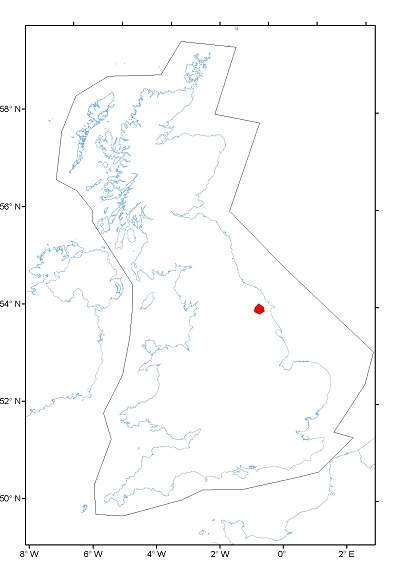Background Activity Rates in the Vale of Pickering
The relationship between the magnitude and number of earthquakes in a given region and time period generally takes an exponential form that is referred to as the Gutenberg-Richter law (Gutenberg and Richter, 1954), and is commonly expressed as
where, N is the number of earthquakes above a given magnitude M. The constant a, is a function of the total number of earthquakes in the sample and is known as the earthquake rate. This is commonly normalised over a period of time, such as a year. The constant b gives the proportion of large events to small ones, and is commonly referred to as the b-value. In general, b-values are close to unity. This means that for each unit increase in magnitude, the number of earthquakes reduces tenfold. Plotting earthquake magnitudes against the logarithm of frequency gives a straight line.
The rate parameter typically varies from place to place, such that an active region will have a higher value than a less active region. Also, in a region of homogeneous seismicity, the value of the rate parameter in any sub-region scales with relative size of the two regions. For example, a region where seismicity is homogeneous and a = 3, will have 1000 earthquakes above a magnitude of zero each year. A sub-region, whose area is ten times smaller will have a = 2, i.e. 100 earthquakes above a magnitude of zero each year. This has important implications for baseline monitoring in small regions, particularly where activity rates are low, since the number of earthquakes in a given period of time may be very low, so longer durations of baseline monitoring are required to reliably determine seismicity rates.
The UK average values for a and b are 3.23 and ~1 respectively. This means that within a polygon enclosing mainland Britain we might expect around 17 earthquakes with a magnitude of 2.0 or above each year. Assuming that seismicity is homogeneous and scaling this number to a smaller area of 400 km2 the size of the Vale of Pickering study region, suggests that there will be an earthquake with a magnitude of 2.0 or above only every 65 years, and three earthquakes with a magnitude of 0.0 or above every two years. This highlights the challenge of reliable estimation of background activity rates in low seismicity regions, since it may require many decades of baseline monitoring to reliably determine rates in small areas if the levels of natural seismicity are low.
Applying the UK average seismicity rate parameter to a 100 km2 square centred on Kirby Misperton suggests we might expect approximately two earthquakes with a magnitude of 2.0 or above every five years. This is largely consistent with the observed number of earthquakes, as 17 events with this magnitude or greater have been recorded in the last 40 years.
References
Gutenberg, B. and Richter, C.F., 1954. Seismicity of the Earth and Associated Phenomena, 2nd ed. Princeton, N.J.: Princeton University Press.
- BGS Environmental Baseline Monitoring
- Government guidance on fracking: developing shale oil and gas in the UK
- Royal Society and Royal Academy of Engineering review of the risks associated with hydraulic fracturing during shale gas exploration and production
- National Research Council, 2012. Induced seismicity potential in energy technologies, National Academies Press
- Seismological Research Letters: Special Issue on Injection-Induced Seismicity.
- British Geological Survey Shale Gas Project


